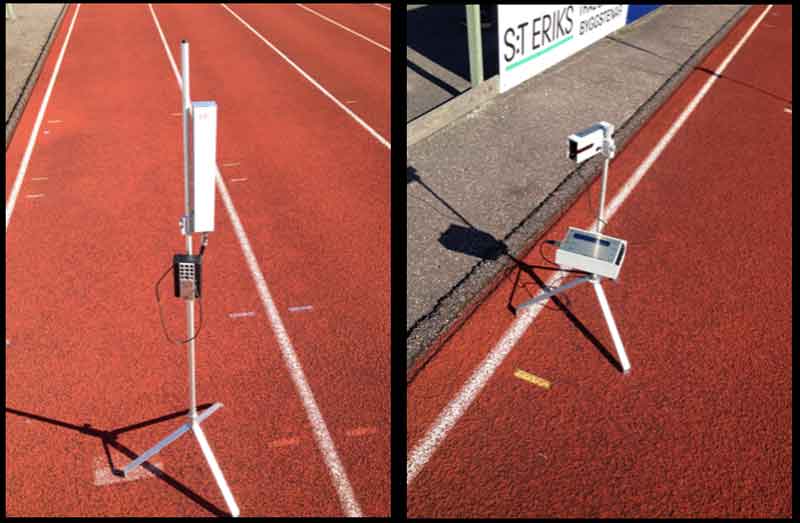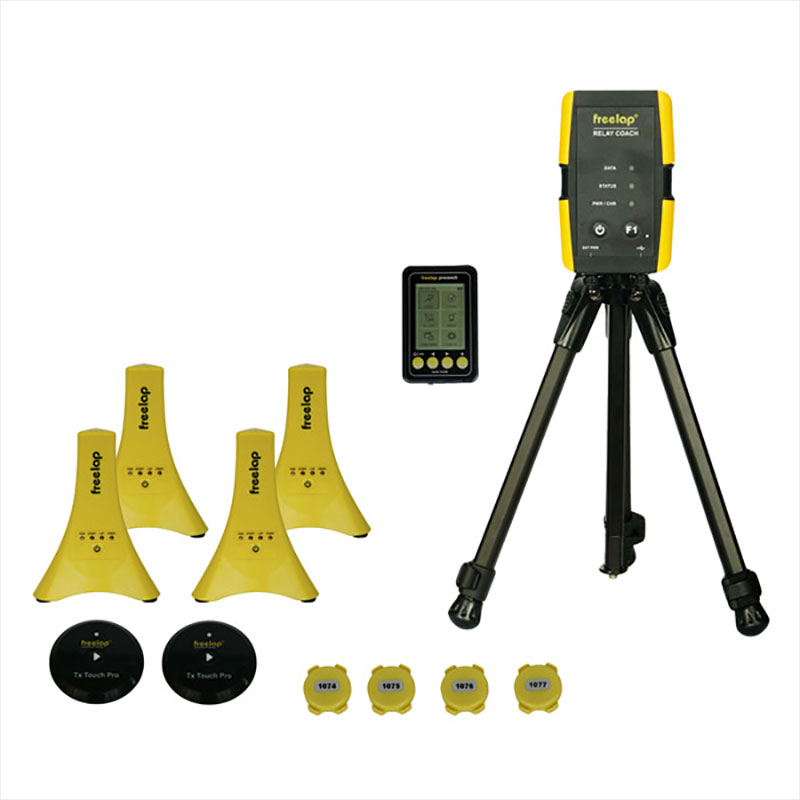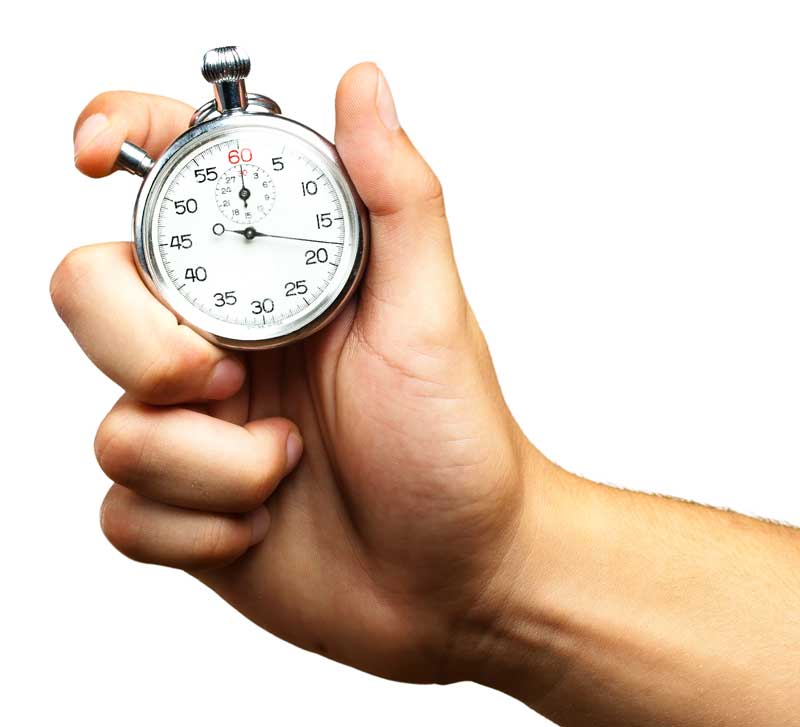
By Carl Valle
Ask a football player what their 40-yard dash time is, and you will, usually, get two different responses—hand time and electronic time. The biggest problem I see with sports training is the simple lack of understanding what electronic timing is when discussing speed development. I have used technology to measure the athletes’ speed since I bought my first video camera, nearly 20 years ago, using frames per second as a crude way to get more accuracy than a stopwatch. I was in high school and wanted to know how fast one of our school sprinters was running in miles per hour, after hearing what Carl Lewis was able to achieve in the early 1990s. A few years later, when talking to a great coach, Jason Trott, who was a strength and conditioning coach in the MLB at the time, he shared his best 40 time, adding“electronic” as a punch line when asked about his own athlete abilities. He scoffed at “hand times” (using a stopwatch), and that conversation in 2000 created a vivid reminder of the simple need for valid measurement of speed. The fundamental lesson in this article is that most performance coaches are paid to make athletes faster, yet if you were to ask about timing and testing, only a small percentage would say they did any. For years we have read about different programs that create breakaway speeds and drop two-tenths in the 40, yet when asked if they had even timed it, the awkward silence is deafening. This article will simply explain how timing is done with various forms of technology and share why it’s dangerous to make claims without testing.
Drops, Gears, Frames, Beams, and Magnetic Pulse

Figure 1: The former USSR had some innovations for military security, and one of them was using beam-based alarms to not only indicate motion detection, but actually fire a gun if an intruder broke in. Beam-based timing is still used by a number of tripods, and track real estate makes me a fan of magnetic pulse technology and its wearable options.
An argument can be made that the first real tool for timing was the water clock that used a drip to count seconds, but it’s likely that the frames of film were the best sources of valid speed measurement. Technology evolves, but science is timeless and must be understood. The first step in understanding electronic timing, before getting into current standards, is to go before electricity and find out how one could capture precise measurements. Most of the changes in technology are more about consumer-friendly evolution than actual improvements in accuracy. We assume that something is not good because it is old. Technology is as ancient the Neanderthals using a marking system on bones for the first time, and we need to appreciate the mathematics and the thought behind the resourcefulness of materials, not by taking into account if the product is using Bluetooth or has a jazzy app.
In my opinion, the most important milestone in sports timing is the use of photography, distance, and simple algebra to get precise timing. The photo finish name conjures up a lot at the finish line, as 2008 and 2012 had two major controversies with Michael Phelps and Allison Felix, respectively. It’s not just the number that people think of; it’s the athlete in time and space that, usually, creates a value of what is going on. Time and speed are all values, but distance enables coaches to visualize speed and time. Currently, after over a hundred years, the photo finish at the end of the race is still the gold standard, because you know who won the race, just as well as how fast they went.
Technically, performance timing started going electronic as soon as people discovered electricity, but for the most part, the idea of removing human reaction or responsibility and introducing a machine automated the process. The inconsistency and human error associated with using a stopwatch made precision and accuracy too unreliable, and equipment improved all areas of timing. The term “fully automatic timing,” or FAT times, became a gold standard because time after time, the equipment worked as designed. It wasn’t that humans couldn’t be trusted, photos would tell of who wins a race, but the practical side of photos when coaches needed convenient measurements of point A to point B became too important to use painstaking techniques such as counting frames to get exact performances.
Timing at the consumer level took off with photocells since coaches wanted something portable and flexible. A sensor to indicate when an athlete initiates movement and when the athlete crosses a specific distance was a perfect match for those wanting something convenient. The light sensor is a beam that indicates when an object passes through, triggering a time stamp specifically on the start and stop. One benefit that photocells had then was the ability to have a series of time segments or splits, allowing a deeper analysis and the ability to see how speed is gained and lost. In the 1980s and 1990s, photocell timing was a standard, and then in the early 2000s, Dartfish was born, and that changed everything. They removed manual frame counting, and the software chronometer allowed not only splits and displacement, but the ability for the coaches to see how time and movement interacted. While this is a powerful feature within the software, it is not instantaneous and must be done manually. Coaches want quick and convenient things like timing devices.
The current milestone is wearable technology matching timing with how fast the body moves, versus a limb or body part hitting the beam. GPS technology is not accurate enough to do sprint testing, and even if it were, you still had to manually break down the information into usable tables of data, such as pairing each segment of distance with a corresponding time. Coaches are familiar with distance and time and prefer finding ways to get faster and lower times, so this is the current direction of evolution. Sensors are small and unobtrusive, and individual athletes are timed based on their displacement, not by tripping over a laser. Now, athletes can be tested at the same time while they are right next to each other, taking advantage of arousal and competitive efforts.
Is a Stopwatch Electronic Timing?
Technically, a modern stopwatch is electronic timing because of the battery, but the manual or human side of its use reduces the accuracy and precision, so it’s not in my book. When one is hand timing, several things can go wrong, and the coach can’t use hand times with authority. Years of use makes a coach more consistent or repeatable, but not more accurate. Some coaches are close, especially on longer sprints with less effect of error. A sprinter running a 150m in 15.6 hand time versus 15.42 electronic isn’t a big deal, but a flying 20m sprint of 2.76 and 2.89 is unacceptable.
What goes wrong with hand timing? A lot more than we think. First, the visual reaction of movement is different with people and even varies with individuals because of sleep and fatigue. This may not appear like much, but the very reason we don’t see hand times at the Olympics is because the lack of confidence in the times being valid, even with a mythical 0.24 second conversion. Do I use hand times? Yes, mainly for circuits, but not for speed.
What about Laser Timing?
As soon as you bring up the word “laser,” many assume that it means the future or science fiction-like technology. Lasers are simply beams of light, and the use of this technology is nothing new. For the most part, the evolution of beam-based technology has not changed in 30 years since all lasers with timers use a binary indication of a body part passing by at a distance. Laser timing only considers the breaking of the light beam and not who or how the beam is broken. Passing by a beam with an extended limb, such as an arm or leg, may affect accuracy by a fraction of a second, but the real constraints with beam timing are the lack of tracking during simultaneous runs and the amount of space needed for tripods. A high school track of six lanes requires half the sprint for one athlete, and even in college or elite standards of eight, this is still too much. Finally, the visual debris in the lane creates what I call a “claustrophobic hallway” effect that you get when visually running with timing gates next to you. While the lane may still be the same width, visually, it has an unnerving response to many athletes who like the free feeling of running without excessive apparatus next to them.
New Technologies and Culture Change

Figure 2: The next evolution in timing is moving away from two gates to get one lane to one sensor for two athlete in two lanes. Not only is this far easier to set up, but it removes the visual, psychological sensation of being squeezed, and allows athlete data to be collected effectively.
One of the major changes in my coaching happened a few years ago when I decided to invest in using the consumer-friendly timing of Freelap. I mainly used video timing, and it was nice when the entire track was mine, but it was impossible to do in groups because it took too long and required no walking in front of the camera, something I had a hard time implementing when on my own. Using a wearable device allowed me to track and aggregate all of the splits and rest periods, and after a year, the simple addition of constant electronic timing fell into a groove. It felt natural, and it allowed me to remove the burden of managing equipment and the fear of missed times. The biggest change came from doing speed work with small groups that were doing sprints at the same time. When doing starts or short sprints from starting blocks or the similar, I could finally get everyone’s time all at once. Everyone knows that when you have a bunch of athletes, the juice starts flowing at once, and the output is higher. Adding measurement and group competition made workouts so much higher that I actually had to worry about overtraining; I adjusted rest periods and efforts later on.
The sensor, be it a chip or a watch, uses a magnetic pulse from the small transmitters to indicate movement through time and space. In the past, a beam was like a finishing ribbon and was not group- or practice-friendly; it was suitable just for periodic testing. After it was liberated from cumbersome gates and changed to small pods that worked with practice venues, timing became a part of enhancing workflow rather than a wrench slowing it down. With the availability of constant and objective feedback and precise data, workouts became more of an engineering project than a trial-and-error (wait and hope) effort. In addition to getting more times in practice, video analysis started doing what it was designed to do—getting kinematic or motion information from the recording—instead of making it difficult to get splits. Timing now is no longer a luxury, but an indispensable part of effective practice.
Electronic Timing Wrap-up
My early Freelap experience was humbling, enlightening, and, best of all, exciting. Having convenient, objective feedback of the most important quality in sports performance—athlete speed—changed how I trained sufficiently to compromise my development if I did not use it on a regular basis. The key lesson here is that, to help people become better, you need to get a clear measurement of change, even if the information is not what you want it to be. By appreciating the sensitivity and slow development of athlete speed, I am far more precise with training and have a clear idea of cause and effect in my practice. While in track and in combine testing you can see the fruits of your labor, you need to make sure your harvest is growing properly and should not wait until it is too late to fix things. Speed is a very clear quality to interpret, so by testing consistently and prescribing very precise workouts, you can help athletes get better results.
Please share this article so others may benefit.
[mashshare]



HI Carl!
As usual, great stuff!
Here is a story relative to this point: Is a Stopwatch Electronic Timing?
Several years ago the executive director for track and field in our state banned me from the state track meet, basically because she felt I was promoting equipment (LYNX Timing) that she believed the state association and its member schools were nowhere near ready to accept or implement.
“Maybe you understand what can be accomplished with your new toys,” she said, “but most coaches in this state think electronic timing is a stopwatch with batteries.”